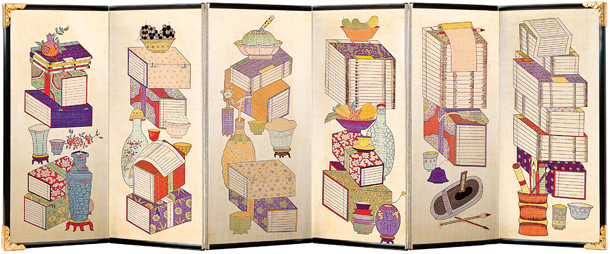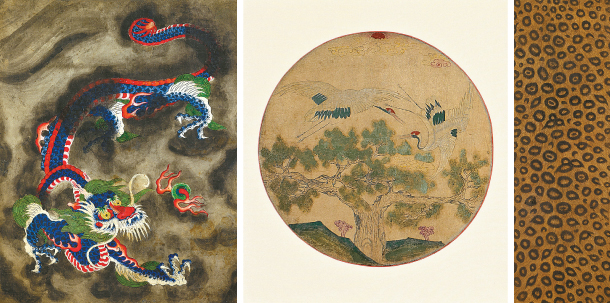Historic folk art speaks to New Year wishes now: Minhwa exhibition links today’s hopes and fears to Joseon

“Embroidered Scholars’ Accoutrements,” a 10-panel folding screen of an embroidery minhwa folk painting is on display at Lotte Gallery inside Lotte Department Store in Yeongdeungpo, western Seoul. The exhibition featuring Korean folk paintings will run through Feb. 24. [LOTTE GALLERY]
“What modern people wish for today in this New Year is not much different to what the people of Joseon wished for hundreds of years ago,” said Cho Eui-young, an Art Director of Lotte Gallery, an affiliate of the Lotte Department Store.
That is why the gallery is organizing an exhibition titled “Baeksubaekbok,” which roughly translates to “long life, many fortunes,” displaying about 20 folk paintings of the Joseon dynasty that were typically put out during the New Year. After the exhibition at the Lotte’s Avenuel Art Hall in Jamsil, southern Seoul, was closed on Jan. 28, the paintings were divided into two groups and were exhibited at the galleries inside Lotte Department Store in Yeongdeungpo and Anyang from Feb. 1. The exhibitions, which are free, will run until Feb. 24.
According to Cho, who curated the exhibition, she split the paintings with care “so that visitors can see different types of folk paintings, such as those of flowers, birds and animals.”
A folk painting boom is underway, and many exhibitions have been organized around the art, long neglected as the works were by nameless painters. Folk painting aficionados have been making efforts to shed new light on the genre, attempting to recover its reputation in recent years.
In part because of this, Cho says this exhibition is being held inside the galleries of a department store. It is focused on giving the general public a glimpse of what “minhwa is, and that it is the painting of the people - not just the people of Joseon but also people of today.”
According to Cho, many of the paintings on display are rare ones that many minhwa fans haven’t seen before. For example, a 10-panel folding screen of “Embroidered Scholars’ Accoutrements” is a rare chaekgeori, drawings of books and study rooms, from the 19th century. Since it is embroidered, experts presume it is a work of a woman and that it was probably a wedding gift. Usually, chaekgeori of court paintings include bookshelves, however, according to Cho, in folk paintings, books and study rooms are only depicted with stacked up books and stationery. This painting features many fruits, which were seen as wishing for the birth of many children. This chaekgeori is exhibited at the Yeongdeungpo branch of the Lotte Gallery.

Some of the Joseon Dynasty minhwa folk paintings that were regarded as lucky, including, from left, “dragon and clouds” (19th century), “Flowers, Birds and Animals” (19th century) and “Tiger Fur” (18th century). [LOTTE GALLERY]
According to Yoon Yeol-soo, the director of Gahoe Museum, the two animals are partners in folk paintings, and this style is the most representative of folk painting of Korea, as “the tiger and magpie paintings depict Korea most closely and very folksy.”
Another popular type of painting to ward off bad luck in the new year were those depicting dragons. In folk paintings, dragons appear together with clouds. Two of these paintings are being shown at the Yeongdeungpo branch.
“During the early and mid Joseon Dynasties, there were more paintings to ward off bad luck than wishing for good fortune,” said Cho. “These paintings of a dragon and clouds is a typical example of munbaedo, which is a type of painting that was used like an amulet.”
Such paintings were put up during Jeongwol Daeboreum, or the first full moon of the year. This year’s Jeongwol Daeboreum falls on Feb. 19.
According to Cho, dragons and clouds were partners for many reasons, and one of the unique reasons is that “the painters found it difficult to draw dragons to the right scale, so they liked to lessen the labor by wrapping the dragon with misty clouds.”
Another rare piece can be found at the Anyang branch.
“Tiger fur” from the 18th century looks exactly like the popular leopard skin pattern many women wear as skirts these days. According to Cho, there are many paintings of tigers in other countries, such as China, but none depict the skin - but those in Korea do, making this type of folk painting very unique.
Of course, there are paintings of butterflies, peonies and birds in the exhibition that symbolize wealth, luck and fortune.
“I hope visitors to the galleries can enjoy the folk paintings and wish for good luck in this new year as our ancestors did,” Cho said.
BY YIM SEUNG-HYE [sharon@joongang.co.kr]










with the Korea JoongAng Daily
To write comments, please log in to one of the accounts.
Standards Board Policy (0/250자)